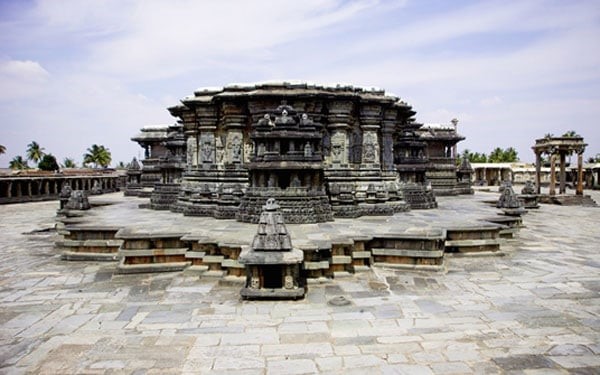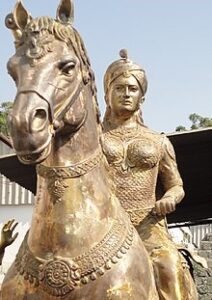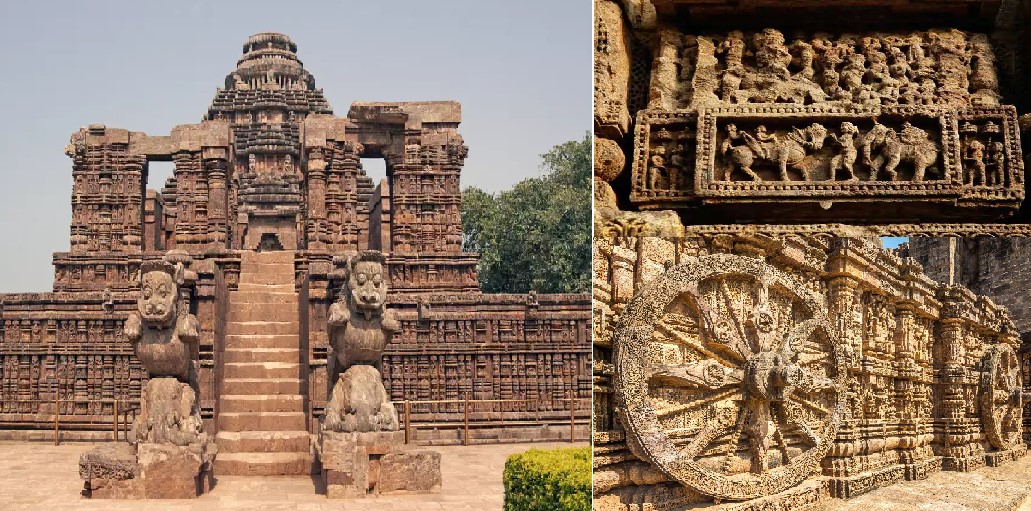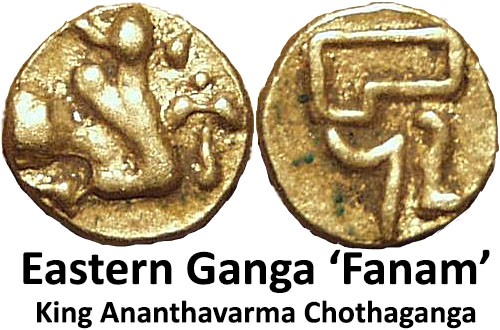Regional Powers in South India and Deccan – UPSC Notes
Regional Powers in South India and Deccan
- After the Fall of Rashtrakutas, Deccan India came under the rule of Western Chalukyas and the Cholas. These powers had to contend with the Parmaras of Dhara and the Kalachuris of Tripuri.
- The Cholas and Western Chalukyas struggled against each other in the 10th-12th century until their powers were in vain.
- The disintegration of the Chola and the Western Chalukyan empires marks the beginning of the 13th century in the history of south India.

The Western Chalukyas – Rise and Fall
- Around the 10th and 12 C.E., most of the western Deccan state was ruled by the Western Chalukyan dynasty.
- The Chalukyas of Kalyan were a feudatory of the Rashtrakutas. Tailapa II used to govern from Tardavadi in present-day Bijapur district, Karnataka, according to a record dated around 957 CE. He killed the Rashtrakuta ruler and declared himself the King over the feudal lords, establishing the Western Chalukyan empire.
- They continuously fought for 200 years with the Cholas and the Eastern Chalukyas of Vengi. The main conflict was about who will control the fertile Vengi region.
- We come to know about the Western Chalukya kingdom through various sources:
- “Gada Yuddha” was written by Ranna, one of the earliest Kannada poets.
- Numerous Kannada Inscriptions: In medieval times, the number of inscriptions on rocks/temples increased dramatically.
- Vikramankadeva Charitam, a Prashasti written by Bilhana about the Western Chalukhyan Vikramaditya VI, in around 1120 in Sanskrit, is the most prominent source for Western Chalukyan history.
- Under the reign of Someshwara I(1042-68) and the military leadership of his brilliant younger son Vikramaditya VI, the Western Chalukyas not only fought against the triple alliance of the Cholas, the Paramaras and the Kalachuris, they also extended their boundary from Central India to the deep south.

- Vikramaditya VI(1076-1126) was the greatest ruler of Western Chalukyas.
- Rise to power: After his father’s death, Someshwara I, his elder brother Someshwara II(1068-76), became the King. However, Vikramaditya rebelled and created a kingdom in the Gangawadi region. He eventually won the Kalyani throne in 1076.
- During the reign of Vikramaditya VI(1076 – 1126CE), the Western Chalukyas were victorious against the Cholas.
- Their territories lie between the Narmada River in the north and the Kaveri River in the south.
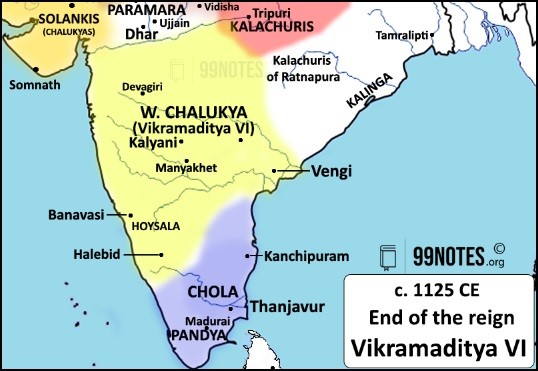
- The other prominent Deccan ruling families, the Hoysalas, the Seuna Yadavas of Devagiri, the Kakatiya dynasty, and the Southern Kalachuris of Kalyani, were subordinates to the Western Chalukyas during this period.
- End of the Western Chalukyas:
- After the death of Vikramaditya VI, Vengi was soon lost to Later Cholas.
- Hoysala declared independence by the mid-12th century.
- Kalachuris captured Kalyani in 1156 and could hold it for only 25 years.
- The Western Chalukyas could regain control of Kalyani, but they could never win over their feudatories.
Kalachuris:
Historians find the first mentions of the Kalchuris of Mahishmati in southern Madhya Pradesh since the 7th century. They remained feudatories of larger powers for most of the time until the rise of Kalachuris of Tripuri.
Kalachuris of Tripuri:
- Till the 10th century, they were feudatories of Rashtrakutas and Pratiharas. However, after the downfall of these two powers, Kalachuris remained feudal kings of the Paramaras.
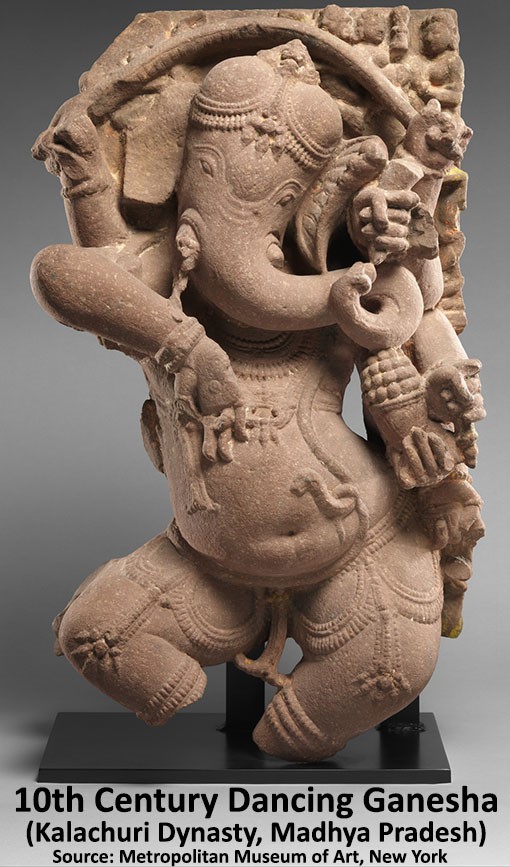
- Gangeyadeva(1015-1041CE) claimed the feudal title of Maharaja instead of Maharajadhiraja, which was the title claimed by the Emporers(King of Kings). He helped Rajendra Chola in his victory against the Chalukyas of Vengi, Kalinga and Palas.
- Lakshmi Karna (1041-1073CE) took the titles Parambhattaraka, Maharajadhiraja(King of kings) and Parmeshwara, indicating that he had other feudatories paying tributes to him. During his time, the Kalachuris reached the peak of their power.
- He subjugated the Chandhelas in the west and the Palas of Gauda and Chandras of Bengal in the East.
- He also defeated the strong Parmaras of Malwa with the help of the Chalukyas of Gujarat(Solankis).
- In the 12th century, the Kalachuris of Tripuri could not hold such large territory but remained the biggest threat to the rival kingdoms of Parmaras, Chandhelas and Western Chalukyas.
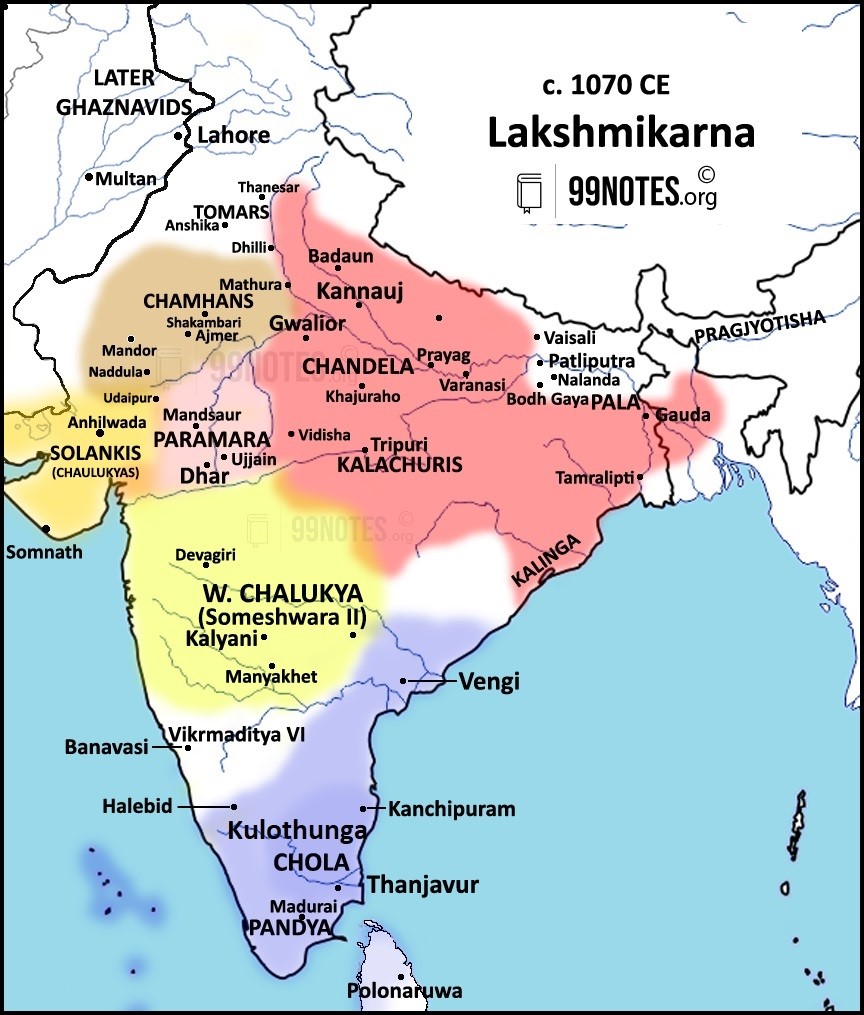
Kalachuris of Kalyani:
- In 1156, Kalachuri kings overthrew the Chalukyas of Kalyani, ending their rule.
- They ruled for a short period of just 25 years. It is unclear how their power originated or how they were related to the Kalachuris of Tripuri. Nevertheless, their rule marks a watershed moment in the socio-cultural history of India.
- Socio-religious Impact: Kalachuris of Kalyani were the patrons of the Lingayatas. Vachana Poetry, composed in the purely native form of Kannada, emerged in this period.
- The Western Chalukyas became too weak after the Kalachuri invasion. This paved the way for newer powers like the Hoysalas to gain territories.

South India before Delhi Sultanate’s Invasion
- After the fall of Western Chalukyas and the Kalachuris, Southern India got divided into various small states, as shown in the following map:

Yadava (Seuna) Dynasty
- For around 300 years, they ruled as the feudatories of the Rashtrakutas and the Chalukyas.
- BhilIama V, the feudatory of the Chalukyas, acquired independent status in A.D. 1187 and laid the foundation of the Yadava rule.
- The Independent Rule: Under Simhana II (1210-46), the Yadavas ruled a kingdom extending from the River Narmada in the north to the River Tungabhadra in the south and in the western part of the Deccan region, from its capital at Devagiri.
Social Impact of Yadava rule:
- They were the first significant dynasty to use Marathi as an official language.
- Saint-poet Dnyaneshwar wrote Dnyaneshwari, a Marathi-language commentary on the Bhagavad Gita, and composed devotional songs called
- Simhanawas a great patron of education and literature. He founded the college of astronomy to study the works of renowned astronomer Bhaskaracharya
- The Sangita Ratnakara, an authoritative Sanskrit work on Indian music, was written by Sharngadeva during Simhana’s reign.
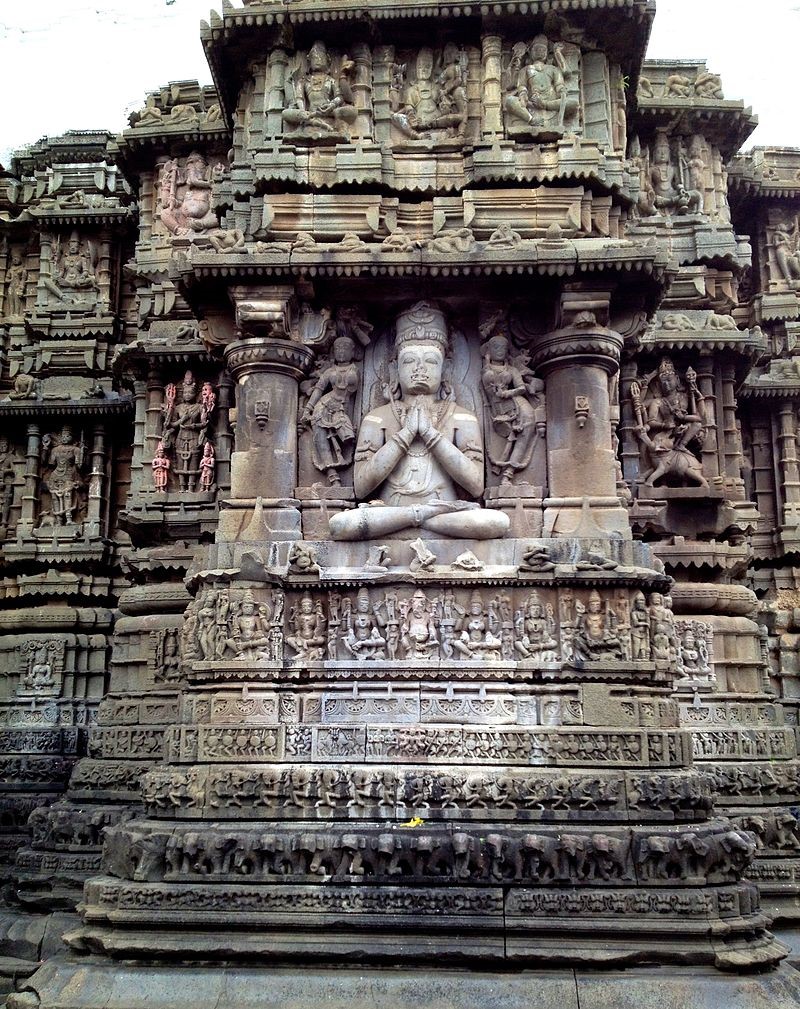 The Aundha Nagnath Temple
The Aundha Nagnath Temple
Hoysala Dynasty
- The Hoysalas ruled over present-day Karnataka and most of the Tamil region from about 1006 to 1346 CE.
- They established their capital initially at Belur but later moved it to Halebid (Dwarsamudra).
- They remained an obedient feudatory of Western Chalukyas against their conflict with Cholas. However, after the death of the western Chalukyan ruler Vikramaditya VI, the Hoysalas tried to declare their independence.
- Independent rule:
- They gained their first victory when King Vira Narshimha(1152-1173) killed the Western Chalukyan King Tailapa III in 1162.
- Narasimha was overthrown by his son Ballala II (1173-1220), the first Independent ruler of the Hoysala dynasty.
- Religious Impact of Hoysala rule: In modern-day Karnataka, three significant religious developments were inspired by three philosophers during the Hoysala era:
- Basava (Lingayataism/Veerashavism): He lived in the late 12th century during the Kalachuri and Hoysala reign.
- Ramanuja (Vishist Advaita): He left the Chola kingdom due to the persecution of Vaishnavites and came to the Hoysala territory.
- And Madhavacharya (Dwaitvada).
Hoysala Art and Architecture
- The Hoysala era was crucial in developingSouth Indian art, architecture, and religion.
- It is remembered for its Hoysala architecture, especially in temple buildings. A Stellate (star-shaped) plan is an essential feature of this type of architecture.
- Hoysala sculptures are made of soapstone, allowing them to make more complex designs.
Star-shape-based Hoysaleshwara Temple, Halebid
Kakatiya Dynasty
- The Kakatiyas were the feudatories of the Chalukyas of Kalyani.
- Rudradeva I, the founder of the Kakatiya state, succeeded in overpowering the Chalukya ruler, Tailapa III, around 1162 CE.
- Their rule extended over most of the Andhra region up to Godavari, Kanchi, Kurnool and Cudappah districts, with the capital at Orugallu (modern Warangal)
Ganapati Deva (1199–1262CE):
- Under Ganapati Deva (1199–1262CE), Telugu’s distinct upland and lowland cultures were united, which brought a sense of cultural affinity between Telugu speakers of both areas.
- He was keen on bolstering the region’s economy. He abolished the taxes on all types of trades except the risky ones.
- Motupalli was an essential seaport during this period.
- He is known for creating Pakhal Lake in Warangal.
The story of Rudrama Devi (1263-1289)Rudrama Devi
Administrative Reforms by Rudramma Devi
Military achievements of Rudrama Devi
|
- Prataparudra, the son of Mummadamma (Devi’s elder daughter), succeeded after Rudrama Devi.
- In 1303, Alauddin Khalji’s forces tried to invade the Kakatiya kingdom with the intention of plundering its riches. In this battle of Upparapalli, Prataparudra’s forces repulsed Delhi’s forces successfully.
- In 1309, Malik Kafur (Alauddin’s infamous General) was sent. He forced the Kakatiyas to pay an annual tribute. He took many horses and elephants, which weakened the empire.
- Ulugh Khan (later Muhammad Bin Tughluq) overran the whole of Telangana in 1322, leading to the end of Kakatiya rule.
Architecture:
-
-
- During the Kakatiya era, a unique architecture emerged that improved and innovated upon the existing styles. The most notable examples are the Thousand Pillar Temple in Hanamkonda Ramappa Temple in the Mulugu district.
- Ramappa temple was recently inscribed as the UNESCO world heritage site. It was built by Recharla Rudri Reddi, a General of Kakatiya ruler Ganapati Deva (1199–1262CE).
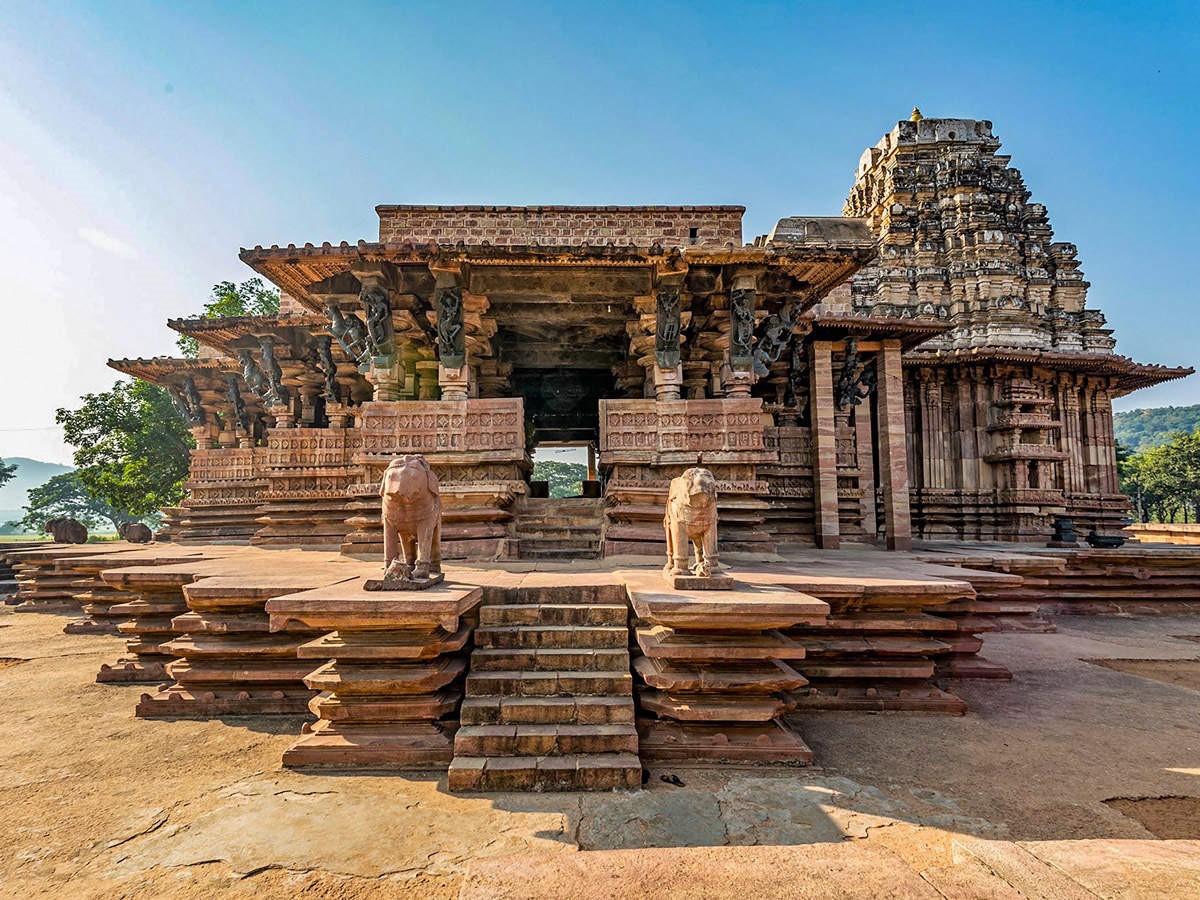
-
Ramappa temple (Source: The Hindu)
Eastern Ganga Dynasty
- After the fall of the Mahameghavahana or Chedi dynasty, the Kingdom was divided into several feudatory chiefs.
- Eastern Gangas (distinct from western Gangas) ruled Kalinga from the 5th to 15th
- They ruled over modern-day Orissa, southern west Bengal, and some parts of Chhattisgarh and Andhra Pradesh.
- Indravarman (498-537 CE) was this dynasty’s earliest known independent ruler.
- Rulers of the period between the 5th century and to 11th century are known as Kalinga rulers. After 1038 CE, the rule of the Trikalinga or Chodganga (After Anantvarman Chodganga) dynasty started.
- Anantvarman Chodaganga was the most important ruler of this dynasty. He assumed the title of Trikalingadhipati (Lord of three Kalingas). Anantavarman was the first King to rule all three Kalinga divisions: Kalinga proper, Utkala in the north and Koshala in the west. He built the famous temple of Jagannath Puri.
- Narsimhadev I, the last strong ruler of the dynasty, built the Konark sun temple to commemorate his victory over Southern Bengal, ruled by a Delhi sultanate Muslim ruler. After his death, the decline of the dynasty started.
The Konark Sun Temple
Source: Wikipedia.
- Kalinga type of architecture: The Gangas were great sentinels of art and literature and built magnificent temples in the Kalinga type of architecture.
-
- Kalinga or Odisha type of architecture is a sub-school of Nagara style, which has already been discussed on the Rajput states page.
- Pillars are not found in this type, and exterior walls are intricately carved while the interior is plain.
- Shikhara of the temple is called Deul; they are almost vertical and suddenly curve inward at the top.
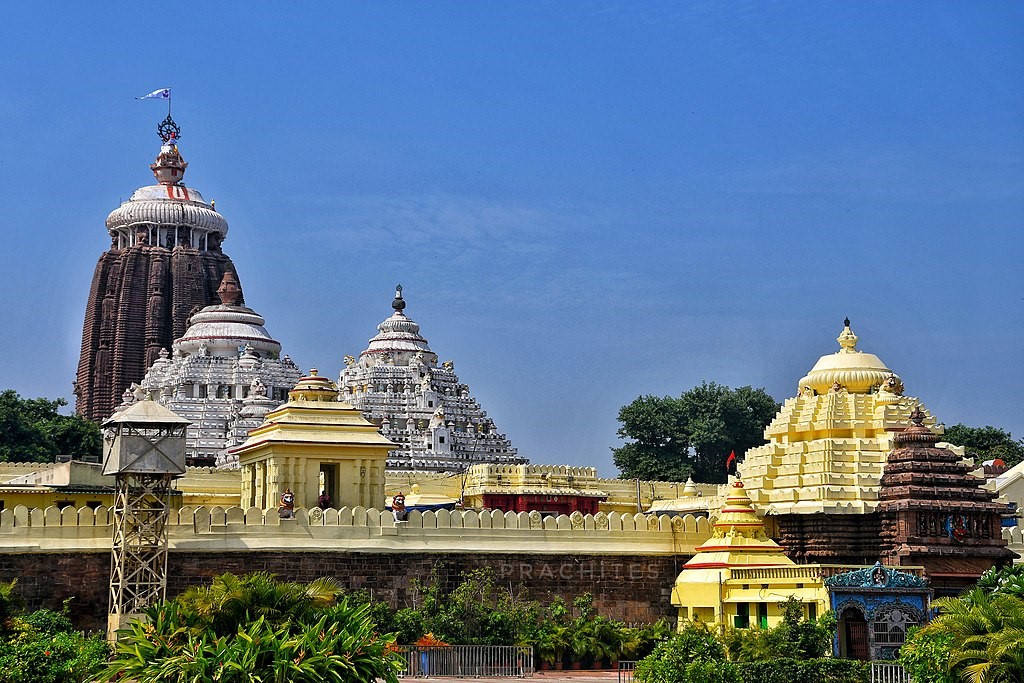
The Jagannath Temple of Puri
Literature:
Marathi literature:
- Under the Yadavas, Marathi became the official language of an empire for the first time in history.
- Saint-poet Dnyaneshwar wrote his Abhanga (devotional text) named Dnyaneshwari in Marathi. It was a commentary on the Bhagavad Gita.
Kannada Literature:
- During this time, the literature of the Three Jewels of Kannada Literature, i.e. Pampa, Ponna and Ranna, got Popularised. Pampa and Ponna were Rashtrakuta poets, whereas Ranna lived during the reign of Western Chalukyas.
- Ranna: Ranna was a 10th-century Kannada
-
- During his early carrier, he may have been patronised by Chavundaraya(minister of the Western Ganga Dynasty).
- With the rise of the imperial Western Chalukya Empire, Ranna became an essential poet in the court of King Tailapa IIand his successor King Satyashraya.
- Satyashraya gave him the title of Kavi Chakravarti.
- The writings of Ranna are in Halegannada(old Kannada).
- Two of the five significant works he accomplished are available in full, and one in part. They are Ajitha Purana, Parashuramacharithe (extinct), Saahasabhima Vijaya (Gadaayuddha), Rannakanda and Chakresvaracharite (extinct).
Telugu literature:
- Early Telugu literature is predominantly religious. Consequently, scholars drew most of their material from the Ramayana, Mahabharata, Bhagavata, Puranas
- The first extant works were from the 11th century when the Mahabharata was first translated to Telugu from Sanskrit by Nannaya.
- Nannaya Bhattaraka:

- He was the writer of the first Andhra Mahabharatam, a Telugu retelling of the Sanskrit Mahabharata. He is a prominent writer of the Champu style.
- Among the Kavitrayam(“trinity of poets”), Nannaya is the first. The trinity consists of Nannaya, Tikkana and Yerrapragada.
- The superiorlanguage used by Nannaya suggests that earlier Telugu literature other than royal grants and decrees need to have existed before him. But those presumed works are misplaced, and Nannaya is considered the Adikavi or the first poet of Telugu literature.
- Scholars also credit him with writing the Sanskrit-language Andhra-shabda-chintamani(the first work on Telugu grammar), but these legends are historically inaccurate, and the text is an imaginary work.
Bilhana
- Bilhana was a Kashmiripoet who flourished around the 11th century in the Western Chalukya kingdom.
- He left his homeland in search of fame and fortune. He wandered through Mathura, Kanuj, Prayaga, Varanasi, Somnath, Kalyan and Rameswaram, but luck eluded him.
- But while trekking back through Kalyan, Western Chalukya EmpireKing Vikramaditya VI appointed him as Vidyapathi.
- Some of the magnificent works authored by bilhana are:
-
- Vikramankadevacharita: Bilhana rewarded King Vikramaditya VI‘s patron by composing, in his honour, an epic.
- Karna-Sundari: It is composed of four acts presenting the secret love affair Of King Karna with the princess vidhyadhari.
- Caura-panchashikan: This masterpiece inspired other medieval Sanskrit poets to follow the Pancha Shila style for amorous descriptions. In its 6 chapters, the monograph presents a fascinating and detailed account of the life and literary career of bilhana.
Vesara Style architecture:
- Several new types of temples emerged in this period, which followed the temple building style of both the North(Nagara Style) and the South(Dravida Style).
- These were known as the Vesara Style of Temples.
- Chennakeshava Temple of Belur and Hoysaleshwara temple of Halebid are prime examples of the Vesara style of Architecture.
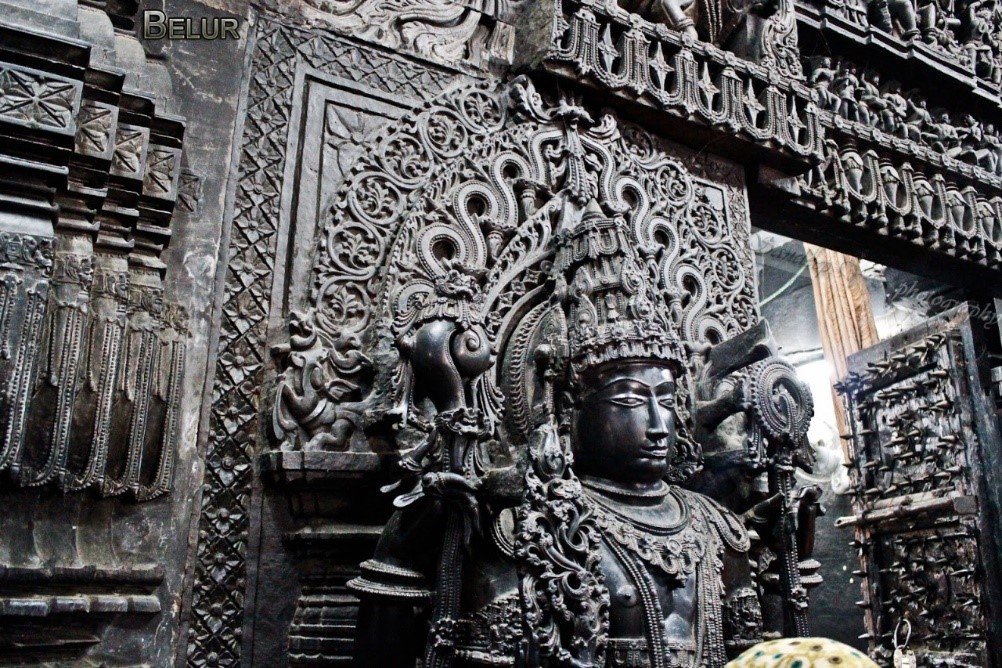
Carvings inside Chinnakeshwara temple
By the start of the 14th century, the regional kingdoms were destroyed by the rulers of the Delhi sultanate, first by the attacks of Alauddin Khalji and then by Mohammad-bin-Tughlaq. In their place, by the end of the 14th century, the powerful Vijaynagar Empire and the Deccan sultanates emerged.


